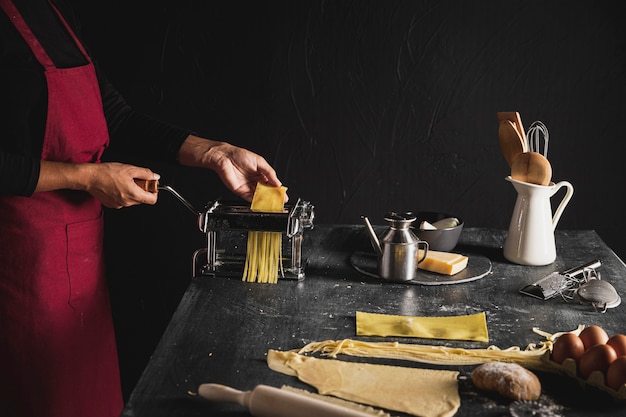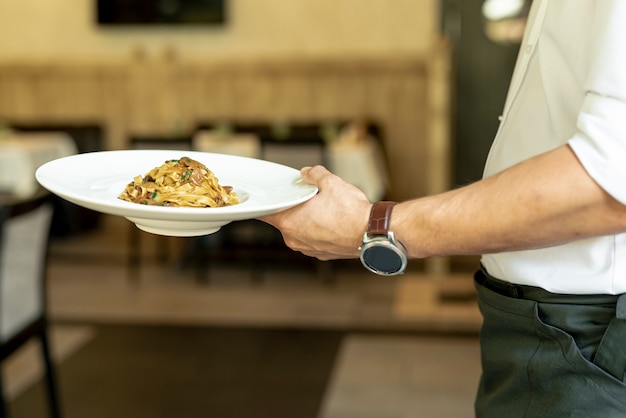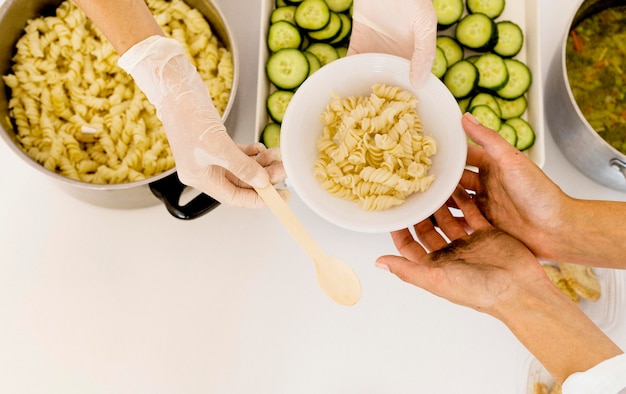There's nothing quite like a perfectly cooked plate of pasta. It's the foundation of countless delicious meals, from simple weeknight dinners to elaborate feasts. But achieving that coveted "al dente" texture, that delightful bite with a touch of resistance, can be a bit of a culinary challenge.
I've been there. I've had my fair share of pasta disasters – soggy noodles swimming in a watery sauce, or crunchy pasta that felt more like a salad. It's a lesson learned, and one I'm eager to share with you today. This guide is your one-stop shop for everything you need to know about pasta cooking time, from the science behind the perfect bite to the secrets of nailing al dente every time. So, grab your favorite pasta pot and let's embark on this culinary journey together!
(Part 1) The Science Behind a Perfect Bite

Before we dive into the specifics of cooking time, let's take a moment to understand the science at play. Pasta is essentially a starched dough made primarily from durum wheat semolina. This semolina is packed with starch, which plays a crucial role in achieving that satisfyingly chewy texture we love.
The Starch Granules: Tiny Culinary Actors
Imagine those starch granules as tiny actors on a culinary stage. They're the stars of the show, and they undergo a transformation during the cooking process. When you toss pasta into boiling water, the starch granules absorb water and swell, becoming more gelatinous. It's like a party for the starch granules, with water being the punch bowl, and they're all getting together for a good time.
But we don't want this party to get out of control! The key is finding that sweet spot, that perfect balance between swelling and softening. We want the starch granules to have a good time but not get too carried away, leaving us with mushy pasta.
Al Dente: The Goldilocks of Pasta Cooking
This brings us to the heart of pasta cooking: al dente. It's an Italian term that translates to "to the tooth," meaning the pasta should offer a slight resistance when you bite into it. It's not crunchy, but it's not mushy either. It's the Goldilocks of pasta cooking – just right!
When pasta is cooked al dente, the starch granules have softened just enough to give it that lovely chew, but they still have a bit of firmness left. That subtle firmness is what makes al dente pasta so satisfying. It's a texture that tells your taste buds that you're eating something fresh and vibrant.
(Part 2) The Pasta Pot: Your Culinary Vessel

You can't just throw your pasta into any old pot. You need a good, sturdy pot, ideally one that's large enough to hold plenty of water and your pasta without overcrowding it.
Choosing the Right Pot
My go-to is a large, stainless steel pot. It heats up quickly and evenly, and it's durable enough to withstand the rigors of pasta cooking. But if you prefer, you can use a pot made from another material, just make sure it's big enough to fit your pasta and allow it to cook properly.
The Importance of Space
The size of your pot is crucial. It's tempting to cram all your pasta into a small pot, but resist the urge! Give your pasta space to move around and cook evenly. A crowded pot will lead to uneven cooking and a mushy mess.
(Part 3) The Water: The Lifeblood of Pasta Cooking

Water is the lifeblood of pasta cooking. It's not just there to keep your noodles from sticking together; it's a vital component of the cooking process.
The Right Amount of Water
Use plenty of water, around 6-8 quarts for a pound of pasta. That might sound like a lot of water, but trust me, it's essential. You want enough water to ensure that the pasta cooks evenly and doesn't stick together. Plus, the more water you have, the less the temperature will drop when you add the pasta, keeping it at a rolling boil.
The Boiling Point
Speaking of temperature, bring that water to a rolling boil! A good, vigorous boil is crucial for cooking pasta properly. The heat of the boiling water helps the starch granules to cook evenly and quickly.
Salting the Water: More Than Just Flavor
Salting the water is not just a culinary trick; it's a scientific necessity. The salt penetrates the pasta and seasons it from the inside out, adding flavor to the core. It also helps to keep the water from boiling over, which can be a messy affair.
Don't be shy with the salt! Use about 1 tablespoon of salt per gallon of water. If you're a salt fiend, you can always add a bit more. Just remember, it's better to add more salt than less. You can always adjust the saltiness of the sauce later, but it's much harder to fix pasta that's under-seasoned.
(Part 4) The Pasta: Choosing Your Culinary Hero
The pasta itself plays a crucial role in the cooking process. You need to choose the right pasta for your dish and understand its cooking time.
Choosing the Right Pasta Shape
The world of pasta is vast and diverse, with a pasta shape for every occasion. But the key is to choose a pasta that's appropriate for your sauce. For example, if you're making a simple tomato sauce, spaghetti is a great choice. It's long and thin, which allows the sauce to cling to it beautifully. If you're making a creamy sauce, penne is a great option. Its ridges provide a surface for the sauce to cling to, ensuring every bite is covered in creamy goodness.
The Pasta Shape and Cooking Time
The shape of the pasta can also influence its cooking time. For example, long strands of spaghetti will take longer to cook than short, thick rigatoni.
Here's a handy guide for different pasta shapes and their cooking times:
| Pasta Shape | Cooking Time |
|---|---|
| Spaghetti | 8-10 minutes |
| Penne | 10-12 minutes |
| Rigatoni | 12-14 minutes |
| Fusilli | 10-12 minutes |
| Farfalle | 8-10 minutes |
fresh pasta vs. dried pasta
If you're using fresh pasta, the cooking time will be much shorter than for dried pasta. Fresh pasta typically takes 1-2 minutes to cook. Dried pasta requires a longer cooking time, but don't worry, the package usually provides a suggested cooking time. Always start with the suggested time as a guide.
(Part 5) The Cooking Process: The Art of the Boil
Now that you've chosen your pasta, it's time to cook it! The cooking process is simple, but it requires a few key steps to achieve that perfect al dente texture.
Adding the Pasta
First, add your pasta to the boiling water. Make sure the water is still boiling vigorously after you add the pasta. If it stops boiling, give it a few minutes to return to a full boil before adding the pasta.
Stirring Gently
Stir the pasta gently to prevent it from sticking together. Don't worry about overcrowding the pot. Pasta will expand as it cooks, and you don't want to end up with a giant pasta ball.
Testing for Al Dente
Now comes the fun part: testing for al dente. I like to use a fork to scoop a few strands of pasta from the pot and check the texture. If it's still too firm, cook for another minute or two. If it's too soft, drain it immediately.
The Bite Test: A Culinary Judgement
Don't be afraid to taste your pasta! This is a crucial step. It helps you to determine whether it's cooked to your liking. I always take a bite to make sure it's al dente. If it's still a bit too firm, cook it a little longer. If it's mushy, it's overcooked.
You'll know you've achieved al dente perfection when the pasta offers a slight resistance when you bite into it. It should be tender, but not mushy. And remember, everyone has their own preference for how al dente they like their pasta.
(Part 6) Draining the Pasta: Avoiding Sogginess
Draining the pasta is a crucial step that often gets overlooked. Done wrong, it can lead to soggy pasta, which is a culinary tragedy.
The Pasta Strainer (Spider)
A common mistake is draining the pasta in a colander over the sink. This can lead to the pasta becoming cold and sticky. The best way to drain the pasta is to use a pasta strainer, also known as a spider. It's a simple tool that consists of a wire mesh basket attached to a long handle.
To drain the pasta, simply lower the spider into the pot, lift it out, and shake off any excess water. Then, immediately transfer the pasta to your serving dish or sauce pan.
Don't Rinse!
If you're using a colander, don't rinse the pasta after you drain it! This will wash away the starch that helps the sauce to cling to the pasta, resulting in a dry and unappealing dish.
(Part 7) The Finishing Touch: Adding the Sauce
You've cooked your pasta to perfection, drained it like a pro, and now it's time for the grand finale: adding the sauce.
Toss Immediately
The key to a delicious pasta dish is to toss the pasta in the sauce immediately after it's been drained. This prevents the pasta from becoming sticky or cold.
pasta water: A Culinary Secret
If you're using a thick sauce, you may want to reserve some of the pasta water. This is the starchy liquid that remains in the pot after you've drained the pasta. It can be used to thin out a sauce and add a little extra flavor.
Add a tablespoon or two of pasta water to your sauce and stir until it's smooth. The starch from the pasta water will help the sauce to cling to the pasta, creating a delicious, creamy finish.
(Part 8) Serving the Pasta: Presentation Matters
The final step is serving the pasta. This is where you can get creative and add your own personal touch.
Serving Style
If you're serving a simple pasta dish, I like to use a large, shallow bowl. It allows the pasta to spread out and show off its beautiful al dente texture.
For a more elegant presentation, try using individual plates. Garnish the pasta with fresh herbs, grated cheese, or a sprinkle of red pepper flakes for an extra kick.
(Part 9) FAQs: Common Pasta Cooking Questions
Here are some commonly asked questions about pasta cooking time:
1. How do I know if my pasta is overcooked?
Overcooked pasta will be mushy and soft. It will lose its bite and become difficult to pick up with a fork. You'll know it's overcooked if it's sticking together in a gooey mess.
2. What happens if I undercook my pasta?
Undercooked pasta will be hard and crunchy. It will be difficult to chew and will likely have a raw taste.
3. Can I cook pasta ahead of time?
Yes, you can cook pasta ahead of time. Just make sure to cook it al dente and then drain it. You can then store it in the refrigerator for up to 3 days. To reheat it, simply add it to your sauce and heat through.
4. Can I add pasta to boiling water directly from the fridge?
You can, but it's not ideal. The cold pasta will lower the temperature of the water, slowing down the cooking process. It's best to let the pasta come to room temperature before adding it to the boiling water.
5. Can I use pasta water for something else?
Absolutely! Pasta water is a culinary treasure. You can use it to add extra flavor and richness to sauces, soups, and even risottos. It's also a great way to make a smooth, creamy sauce.
And there you have it! This guide has been my pasta cooking bible for years, and it has helped me achieve al dente perfection every time. I hope it does the same for you. So, next time you're craving a plate of pasta, remember these tips. It'll make all the difference in your pasta-making experience!
Everyone is watching

Perfect Rice Every Time: The Ultimate Guide to Cooking Rice
Cooking TipsAs a self-proclaimed foodie, I've always been a bit obsessed with rice. It's the foundation of countless cuisi...

Prime Rib Roast Cooking Time Chart: Per Pound Guide
Cooking TipsPrime rib roast. Just the name conjures images of lavish dinners, crackling fires, and hearty laughter. It’s ...

The Ultimate Guide to Cooking Asparagus: Tips, Techniques, and Recipes
Cooking TipsAsparagus. The mere mention of this spring delicacy conjures up images of vibrant green spears, crisp and burs...

Ultimate Guide to Cooking the Perfect Thanksgiving Turkey
Cooking TipsThanksgiving. Just the word conjures up images of overflowing tables laden with delicious food, the scent of r...

How Long to Bake Potatoes in the Oven (Perfect Every Time)
Cooking TipsBaked potatoes are a staple in my kitchen. They're incredibly versatile, delicious, and surprisingly easy to m...
